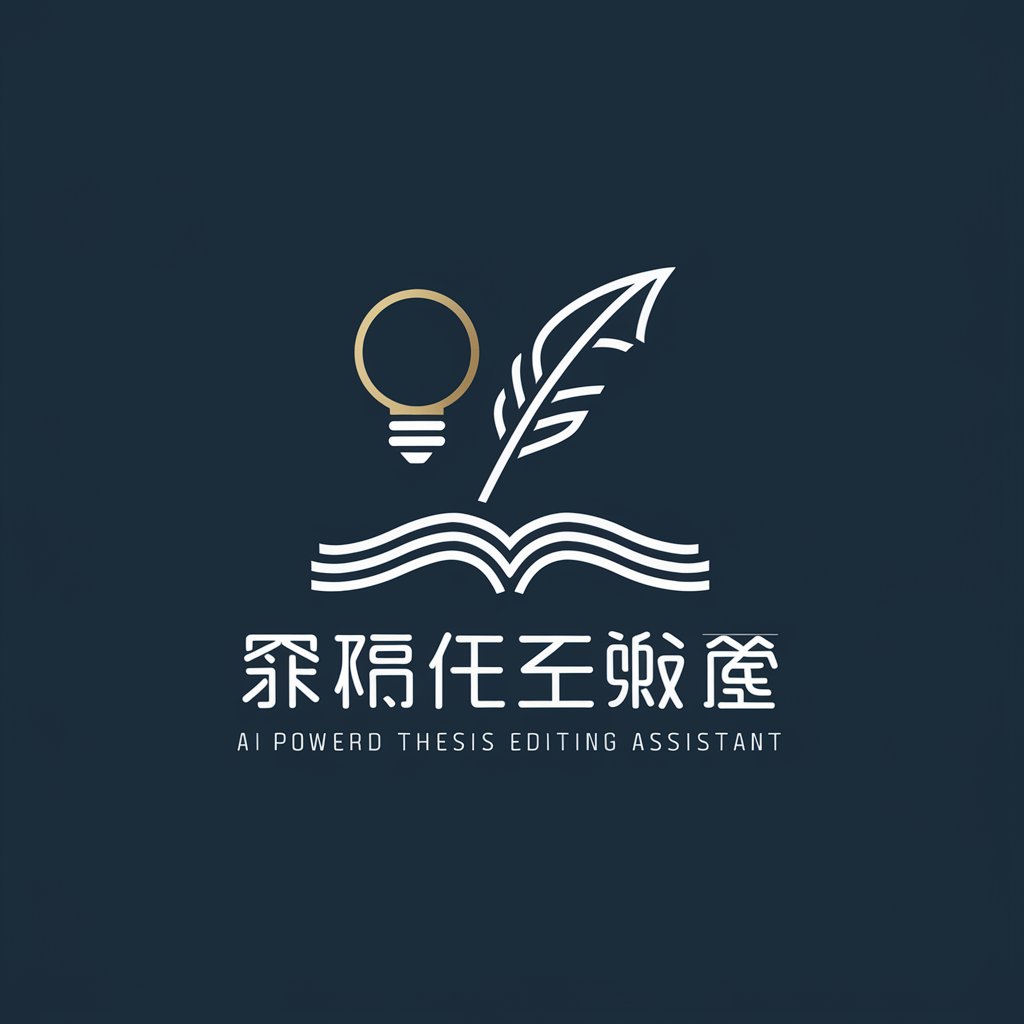
SCI论文写作助手 - AI writing assistant for research.
是一个可以帮助你撰写SCI论文的功能。它可以根据你的研究主题、研究问题、研究目的、研究方法、研究结果和研究结论等信息,为你生成一份符合格式要求和内容要求的SCI论文草稿,包括标题、摘要、关键词、引言、文献综述、研究设计、数据分析、讨论和参考文献等。它还可以提供一些参考文献和范文,帮助你完善和优化你的SCI论文。
AI-powered research paper writing assistant.
Get Embed Code
Introduction to SCI论文写作助手
SCI论文写作助手 is a specialized tool designed to assist researchers, especially those aiming to publish in SCI (Science Citation Index) journals. Its primary purpose is to help users navigate the complex process of academic writing by providing support in areas such as research problem formulation, literature review, data collection, statistical analysis, and manuscript preparation. The tool is intended to streamline the often arduous tasks involved in producing high-quality research papers for peer-reviewed journals, enhancing both the efficiency and quality of research outputs. For example, a PhD student working on their dissertation may struggle with identifying gaps in existing literature. SCI论文写作助手 would assist by helping the student gather and organize relevant research articles, summarize key findings, and identify potential gaps for further investigation. In another scenario, a professor preparing an empirical study for a high-impact journal could use the assistant to design the study’s methodology and analyze the collected data using proper statistical methods. Powered by ChatGPT-4o。

Main Functions of SCI论文写作助手
Formulating Research Questions
Example
A master's student in environmental science may need help narrowing down a broad topic like climate change impacts. SCI论文写作助手 guides the student to specify a research focus, such as the effects of rising temperatures on a specific ecosystem, which leads to a clear, researchable question.
Scenario
Graduate students or early-stage researchers unsure about how to define their research questions can benefit from this function. The tool suggests targeted areas based on current literature trends and gaps, helping the researcher formulate precise, high-impact research objectives.
Literature Search and Review
Example
A researcher preparing a systematic review on medical imaging techniques can use SCI论文写作助手 to collect and filter thousands of articles from databases such as PubMed and Web of Science, ensuring that the selected articles meet predefined criteria for quality and relevance.
Scenario
This function is vital for researchers who need to handle large volumes of literature. It enables users to automatically gather, screen, and organize papers, saving time while maintaining a focus on the most relevant studies for their field.
Manuscript Drafting and Structure
Example
An engineering professor writing a paper on machine learning models may struggle with the appropriate structure of their article. The assistant offers a guideline for each section, such as how to properly present the methods, discuss the results, and provide meaningful conclusions.
Scenario
This function is particularly useful for academics who are new to the SCI journal writing style, ensuring that their paper conforms to expected structural norms and enhances clarity and readability for reviewers.
Data Analysis and Interpretation
Example
A biostatistics researcher conducting an experiment on drug efficacy can use the tool to choose appropriate statistical methods for data analysis, helping them interpret complex results such as p-values, regression analyses, or ANOVA tests.
Scenario
This is essential for empirical researchers who work with large datasets and need to ensure statistical accuracy and meaningful interpretation of results, particularly in fields like medicine, biology, or social sciences.
Journal Selection and Submission Guidelines
Example
A researcher aiming to publish in a high-impact chemistry journal might be unsure about where to submit their paper. SCI论文写作助手 provides recommendations based on the research focus and impact factor, guiding the author to the most appropriate journal.
Scenario
This function is valuable for those who have completed their manuscript but are uncertain about which journals are the best fit, helping to maximize the chances of acceptance by aligning the research with journal expectations.
Ideal Users of SCI论文写作助手
Graduate Students
Graduate students, particularly those pursuing master's or PhD degrees, often struggle with the process of academic writing. Whether they are formulating their thesis research question or navigating the complexities of a literature review, SCI论文写作助手 offers targeted support. For these students, the tool simplifies difficult stages like manuscript structuring and data interpretation, allowing them to focus more on their research findings than on technical writing aspects.
Early-Career Researchers
Researchers at the beginning of their careers may not yet be familiar with the rigorous standards of SCI journals. For them, SCI论文写作助手 provides valuable guidance on journal selection, manuscript submission, and citation standards. This group can particularly benefit from the platform’s ability to recommend journals and ensure that their papers meet the expectations of peer reviewers and editors.
Senior Researchers and Professors
Even experienced researchers can benefit from SCI论文写作助手 when they are working on large-scale projects or need assistance with data analysis and statistical methods. These users may also need help staying up to date with recent publications in their field, for which the tool’s literature review function is invaluable. Additionally, it helps streamline the manuscript drafting process, ensuring consistency and adherence to journal guidelines.
International Researchers Writing in English
Non-native English-speaking researchers often face challenges when writing papers for English-language journals. SCI论文写作助手 helps by providing feedback on the language, style, and structure of the manuscript, ensuring that it meets the linguistic standards expected by international journals. This can be critical in improving the overall readability and quality of the paper.

How to Use SCI论文写作助手
Step 1
Visit yeschat.ai for a free trial without login, also no need for ChatGPT Plus.
Step 2
Define your research question and objectives based on your interests and background knowledge.
Step 3
Use the assistant to search, collect, and screen relevant literature from various databases such as Google Scholar, Web of Science, and CNKI.
Step 4
Read and organize the literature, focusing on key points such as methods, results, and conclusions to form your own analysis and critique.
Step 5
Draft, revise, and finalize your research paper using the assistant’s tools for writing, data analysis, and formatting according to SCI journal standards.
Try other advanced and practical GPTs
Coran et Hadith Sahih
Unlocking Islamic knowledge with AI

기도왕 - 기독교 / 신앙 / 교회 / 예배 / 성경 / 하나님 / 예수님
Your AI-powered spiritual companion

Read Doc and Answer Questions
Unlock knowledge with AI-powered analysis

Software Architect Assistant
AI-powered Software Architect Guidance

Vietnamese Translator
AI-powered translation and definitions

영상 스크립트(대본) 작가(video script writer)
Automate Video Scripts with AI

专业学术论文写作助手
AI-powered tool for academic precision.

Risk Manager GPT
Empowering Risk Decisions with AI

Risk Assessment Generator
AI-powered Risk Assessment Creation

数学建模助手
Power your research with AI-driven modeling.

Astro Expert
Empower your code with AI-driven guidance.

Uniqueness Statement Generator
AI-Powered Uniqueness Amplifier

SCI论文写作助手 Q&A
What is SCI论文写作助手?
SCI论文写作助手 is an AI-powered tool designed to assist with the entire process of writing and publishing scientific papers, from defining research questions to finalizing manuscripts.
How can I access SCI论文写作助手?
You can access SCI论文写作助手 by visiting yeschat.ai for a free trial without the need for login or ChatGPT Plus.
What databases can I search with SCI论文写作助手?
You can search through various academic databases including Google Scholar, Web of Science, and CNKI to gather relevant literature.
How does SCI论文写作助手 help with data analysis?
SCI论文写作助手 offers tools for statistical analysis and interpretation, helping you to analyze collected data and draw meaningful conclusions.
Can SCI论文写作助手 assist in formatting papers for specific journals?
Yes, SCI论文写作助手 provides guidelines and tools to format your paper according to the standards of different SCI journals, ensuring compliance with submission requirements.




